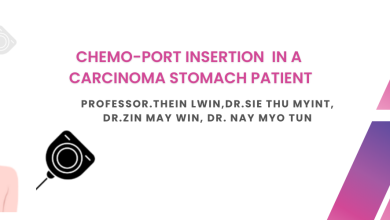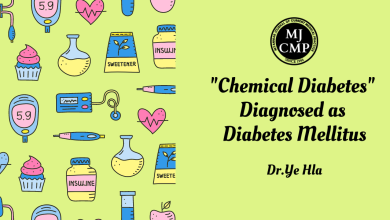An Interesting Case of Tetanus

This is a report of the management of a case of severe tetanus, successfully treated by good anticipation.
A 31-year-old lady doctor who noticed heaviness of facial muscles and her jaws at about 10:00 am on April 11/76. When I saw her 17 hours later (3:00 am on April 12/76) she had neck and back rigidity with risus sardonicus. Having diagnosed her as a case of Tetanus, she was admitted to Isolation ward at D.S.G.H. Routine treatment with antitoxins and toxoid was given (Patient has had 3 doses of T.T. previously). She had no external wound and because of a vaginal discharge, she was seen by O.G. Specialist Dr. Daw Khin Myint Myint. On examination, the purulent discharge was seen on posterior fornix and the I.U.C.D. (Copper T) was removed. The patient began to c/o pain in abdominal and back muscle with some difficulty in breathing at 2:00 pm (ie 28 hours after the on-set of symptoms).
A tracheostomy was performed under local and a D & C was performed under Endotracheal G.A. through the tracheostomy tube. A Ryles tube was also inserted. A venous cut down and an indwelling urinary catheter was also introduced.
Patient started to have spasms whose interval became shorter as its duration became longer.
– 29 hrs after admission the 1st prolonged spasm with cyanosis occurred, which lasted about 5 minutes and the patient was put on the Bird Respirator. The patient was receiving
- V. Geopen. IG 6/H
- V. Synthomycetin 500mg 8/H
- V. A.T.S. 30,000 I.U.
- V. Valium 10 mg 8/H
- M. Paraldehyde 5 ml 6/H
As reflex spasms became more frequent I.V. valium dosage was increased to 40mg 8/H. Inspite of such a dose, pt. went into prolonged spasm with cyanosis for two more times which required the assistance of the respirator. By then, we were using I.V. valium 100mg 8/H and I.M. Chlopromazine 50mg 8/H – (ie. Valium 300mg and Chlorpromazine 150mg per 24 hrs was being used). Then only, the spasms became well controlled.
As the patient improved, the drugs used were tailed off slowly (over a period of 20 days).
The tracheostomy tube was changed for a smaller size tube after 2 weeks. Her indwelling catheter was changed aseptically every 3rd day.
The Ryles tube was removed after 18 days and the tracheostomy tube was removed after 20 days. In dwelling catheter was removed after 10 days.
The patient still had a lot of residual muscular stiffness for which she received treatment at the Department of Physical Medicine. On mobilization, she complained of precordial pain and breathlessness. E.C.G. shows evidence of myocardial strain and the patient was asked to take things easy. The patient was discharge on May 29/76 (1 month 16 days) with residual stiffness of the shoulders, neck and back muscles.
Discussion
There is no doubt that this is a case of severe tetanus. Site of entry cannot be defined clearly, though there is clinical evidence that it could be in the uterus.
We feel that her previous inj. of T.T. did not modify the course of the picture in view of the tempo of development of her symptoms. It is felt that the main reason that she survived was good anticipation on the part of the hospital staff i.e.,
(1) A tracheostomy – respirator could be used at once which saved her 3 times.
(2) Venous cut down – Giving drugs urgently.
(3) Ryles tube – Maintained her nutrition and fluid balance.
(4) Valium – It was at the suggestion of Dr. U Thein Htay Pe that we were bold to go on increasing the dosage of valium till spasms were controlled. We feel this together with Chlorpromazine controlled the spasms.
(5) Nursing Care – She received excellent nursing care from her family which really tipped the balance in her favour.
(6) Drugs – We did use good doses of antibiotics and A.T.S. We feel the antibiotic helped us very much.
We would suggest that the above (6) factors be carried out without delay in the management of future severe cases of Tetanus.
D.N. Biswas,
Why was an alternative method of management by muscle relaxant and intermittent positive pressure respiration (I.P.P.R.) not adopted in this case.
U Maung Maung Sein
We have not completely put her on muscle relaxants and IPPR, because in the first place our anaesthetic services are hard pressed, only during severe spasms or respiratory difficulty we put her on a respirator each time lasting from 15 to 30 minutes. As soon as she can respire or the spasms went away we switched off the respirator. If we use muscle relaxants we would not be able to turn off the respirator so soon. With the lack of adequate biochemical analysis also it will be difficult to manage on continuous use of respirator. That is why we used it only when she needed it.
U Aung Khin
I would like to support the speaker and stress some important points. Tetanus is a self limiting disease. I agree with you it is not the antiserum that saves the patient’s life. We have been treating cases of tetanus without ATS when it went out of stock for one and a half years with comparable results. I also support in anticipating life threatening complications and taking measures before they occur. Nursing care and life saving measures keep the patient alive. When toxicity wears off the patient gradually recovers. It is also a very wise decision in doing a D & C on her. In cases of Tetanus the focus of infection must be removed.
U Maung Mg Sein
We had quite a lengthy discussion with the gynaecologists about this procedure. There are also some who disagrees with this procedure claiming that it will cause further release of toxins and made her condition worse. Fortunately the gynaecologist to whom I refer this patient agreed with me and we proceeded with the D & C. May I have some opinion from the gynaecologist.
Prof: U Soe Myint
We have a lot of puerperal tetanus in Mandalay so also will be here in Rangoon. I am in full agreement with you even if the patients are very ill. When these patients have severe fits some think surgical intervention is not advisable. I do not think this fatalistic attitude is correct. We have a number of puerperial sepsis and we treat them conservatively at first. But sometimes surgical intervention is called for and we even did hysterectomy, because if the focus of infection is in the uterus, it has sometimes to be removed. This radical surgery has saved some patients’ life. One should do everything possible that one can. I remember one case, a captain’s wife with a very severe puerperal tetanus, I refused to send her down to Rangoon as I believe the mortality rate is very high there. I treated on the same line as you have described and she ultimately recovered. So also in Mandalay General Hospital, the care is very poor in Tetanus ward. I believe the care of these patients is very important and one should not take a fatalistic attitude even if the condition is very serious.
U Maung Mg Sein
We staged this patient as a severe form of Tetanus. In fact our physician at first assessed her as mild form. But I anticipated a severe form and did all precautionary measures. That very morning she had a very severe spasm which made her blue. The respirator is of great use at this space. The cardiac strain at this stage was so great that she had attacks of angina and the physician had to give the usual cardiac support. I am wondering whether some form of cardiac myopathy exist in severe forms of Tetanus.
Major Mya Thein Han
Usually we assess the severity of Tetanus from the duration of the incubation period. In this patient what criteria did you use to anticipate a severe form?
Open Session
U Maung Mg Sein
The history was she felt a little funny on her side of the neck at 10 A.M. She was unable to swallow by 5 p.m. Then she could not open her mouth fully by 12 mid-night. She came to me early in the morning at 3 A.M. This sequence or progress of symptoms is just too fast to arouse this possibility.
Prof. U Khin Mg Latt
It is not true that majority of tetanus patients sent to R.G.H. die. At present under my supervision, even with inadequate staff and facilities, mortality rate is 40%.
Comment on Dr. U Maung Maung Sein’s treatment of Tetanus. As for ATS, Tetanus can be cured without ATS, although ATS gives some benefits. Tracheostomy is only done when it is definitely indicated. There was one professional singer, on whom, although it was indicated, the condition was tided over and she was cured without Tracheostomy performed on her. Nasogastric tube feeding is very useful especially when the patient has dysphagia. We put in this tube on admission in all patients to be removed after a few days if now it seems unnecessary. Majority of the emotional lock- jaw patients (hysterical) get cured on introduction of this tube.
Valium Injections in high doses is useful, the sedation should be adjusted to the requirement and to be reduced gradually and promptly when the condition improves, oversedation and prolonged sedation has disadvantages.
Chairman
I believe there are many things to be said about Tetanus. It does not spare any part of the body. I remember a case reported by Dr. Thein Nyunt from B.M.H. When a Prof: from U.K. visited Maymyo, BMH, he saw a little Goorkha girl in the ward giving him a little grin. He was so impressed that he took a photograph of her for her beautiful smile. She later developed Tetanus. That smile is probably what is described in the western literature as “sardonic smile”. That was an instance of Tetanus.
Commentary
Win Myint2
This case report was presented in the open session of Myanmar Medical Conference in 1977. The presentation was made by the surgeon, U Maung Maung Sein (he was the, then the lecturer in Department of Surgeon, IM 2).
He treated a lady doctor with a severe attack of Tetanus in April, 1976 in Defense Services General Hospital (DSGH). Saya has treated successfully with anticipated planned of management and a miracle outcome.
The open session of (clinical sessions) of Myanmar Medical Conferences those days were lively and inspiration for next generations of doctors attending the conference. Mentors from various specialties never fail to attend the clinical sessions and contribute their experience and opinion.
We all learned a lot, attending these annual conferences held in Myanmar Medical Association building.
Regarding the subject discussion, Tetanus was fairly common those days. It is notorious for high mortality rate in surgical practice. Prophylaxis and proper wound care and management is the main key factor to bring down the mortality rate. Active immunization is more effective than passive immunization (Tetanus toxoid/Anti-tetanus serum). Serum reaction is the main concern, when using ATS (Anti-tetanus serum). Severity of tetanus is determined by:
- Incubation period
- Period of onset
Incubation period is the time interval between injury and onset of early symptoms of Tetanus.
Period of onset is the time interval between the first symptom and the first reflex muscular spasm. Incubation period is usually not definite with wide variations, thus, no clinical value. Period of onset is more accurate, reliable and has prognostic value. Monograph on Tetanus, emphasized on the unique pathogenesis of clostridium Tetani. It is quite surprising to realize that the exotoxin of clostridium Tetani, once fixed to the motor end- plate, cannot be detoxified and its action can persist for months, till it is completely disintegrated.
Fortunately active immunization can reduce the incidence and mortality rate of Tetanus.
Tetanus vaccine (Tetanus Toxoid) is added to the National Immunization Programme in Myanmar, aiming to eliminate Tetanus Neonatorum.
Tetanus is now rarely seen in our daily clinical practice.
Author Information
Maung Maung Sein1, Win Myint2
1.Retired Director General,
Department of Health Manpower, Ministry of Health
2.Patron
Department of Surgery, PunHlaing International Hospital





